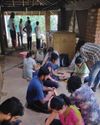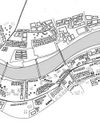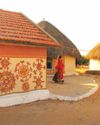The Kumaon, Kasar Devi Village, Uttarakhand
Designed by Sri Lankan firm Zowa architects, The Kumaon attempts to find an ideal balance between luxurious modernism and the rustic charm of natural, serene village life. Using simple, natural materials the design involves minimal interventions to retain the ethos of the site while creating a hidden-gem that offers a holistic experience in the lap of nature that aspires to try and fulfill our age-old search for tranquility.

If human race ever advances so much that we manufacture feelings, pack them up in pretty bottles and sell them, peace and tranquility would probably be bestsellers. But that’s just wishful thinking. In reality, our search for peace and tranquility has been historically documented. And much of this quest has lead us back into the lap of nature more often than not. And yet, ironically, we’ve never been shy of destroying nature in the name of development. Our cities and increasingly rural areas too, are being stripped off of their green cover at an alarming rate; of course, we realise this and are taking measures to reverse the years of damage we have unleashed on the planet. But to relax and rejuvenate, we often retreat to areas untouched by man, to bask in their bountiful glory, reconnect with the earth, the crisp air, and the sky.
This need has given rise to a variety of nature retreats and resorts all over the world. Especially in India, hill stations are not only a great way to escape the hustle and bustle of unorganised urban life, but also an ideal way to beat the harsh heat, pollution and stresses of daily life. The higher altitudes, thick natural cover, lush greens, clear skies, lesser people… everything contributes to a holistic experience, even if for a short while. But more often than not, the so-called nature resorts are not so natural. Often, you are enclosed in concrete boxes with views opening into other concrete boxes. In such scenarios, the search for tranquility often translates to urban luxuries in a semi-natural setting.
This story is from the June 2018 edition of Indian Architect & Builder.
Start your 7-day Magzter GOLD free trial to access thousands of curated premium stories, and 9,000+ magazines and newspapers.
Already a subscriber ? Sign In
This story is from the June 2018 edition of Indian Architect & Builder.
Start your 7-day Magzter GOLD free trial to access thousands of curated premium stories, and 9,000+ magazines and newspapers.
Already a subscriber? Sign In

Interlacing Perspectives
‘Meraki-2019’ A visionary Seminar series presented by Dr.Baliram Hiray College of Architecture, Bandra(East), Mumbai.

Facilitating A Community Through Architectural Practice
The humble, self-designed, self-built and organically planned home built by the majority of the world population rarely gets appreciated and critiqued as a viable lesson in architectural design.

The Art Of Solving Problems Creatively
The practice of architecture is perhaps incomplete without the complement of a variety of other arts.

Upcycling towards a playful tomorrow
Play is like the middle child, often forgotten, and always taking a back seat. For young kids, play can simply be running around, armwrestling with friends, building sandcastles on the beach, or singing popular music tracks in the shower.

Balancing The Poetics And Pragmatism Of Everyday Design
Humanity is faced with an oxymoronic crisis. The crisis involves the earth, the environment, impending looms of climate change, deforestation, loss of species, dwindling resources etc.

Just Give Me Some Space: Discussions And Beyond
Just Give Me Some Space (JGMSS) is Suha Riyaz Khopatkar’s debut book that paints a portrait of the dynamic life of an architecture student.

The Next In Vernacular Architecture
Architecture has become a capitalist.

Rethinking The Future: Architecture And Its Education
“I want to be like animals, the bird makes a nest in one or two days, the rat digs a hole in a night, but intelligent humans like us spend 30 years to have a house, that’s wrong.” - Jon Jandai

Uniting The Human-Scale With The City-Scale
London-based architect Usman Haque is famed for his interactive architectural systems, and for his exploration of newer, more effective ways of creating human engagement and interaction through his designs. Indian Architect & Builder caught up with him, to quiz him on a variety of topics such as his journey as an architect, his inspirations and philosophies, architects using the digital revolution to their advantage, and more!

Framing spaces
Almost every architect also doubles as a photographer or at least an enthusiast.